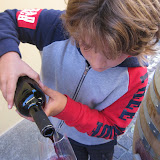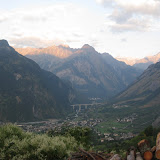Regardless, it's done now. And so is dedicating entire blog postings to one winery - with sometimes 3 or 4 cantina visits in one day it's too hard. From now on they will be grouped together in an intelligent manner; for example, this posting is going to be about my rapid 3 days in Lombardia - minus the 24 hours spent in Lake Como. (Sorry you non wine-loving readers, you will have to wait for my Northern Italian surf 'n turf posting to hear about Como.) The wineries featured are:
Bellavista (Franciacorta)
 |
| Bellavista Franciacorta |
Nino Negri (Valtellina)
Aldo Rainoldi (Valtellina)
 |
| VALTELLINA (Negri and Rainoldi) |
So, to continue from where I left you hanging upon departing from Piemonte, after an afternoon and evening in Milan my friend Tasha (who had joined me from the States to drive through mountainous northern Lombardia) and I departed early to head to Franciacorta for an appointment at Bellavista. We were met by Alberto Chioni, the head of their marketing, for an in-depth tour of the cantina and an impressive lunch to follow.
The Franciacorta zone is very unique in that it is a glacial basin situated between the Orobie Alps to the north (which separate it from the more northerly Valtellina, which you'll hear about next) and the hills of Monte Orfano. Also included in this little pocket is the Lago d'Iseo, which helps moderatate the climate. indeed, when approaching by car the landscape is totally flat until you are within - which you don't even realize until you get out of the car and have a look around at the massive hills that seem to have just popped out of the earth, with mountains looming both around and beyond the lake to the north. As such, the soils were brought by the alps (in a glacial movement) and are a mix of clay and stone.
Like everywhere else in Italy, winemaking has been going on for centuries here, though it has only become an area with prominence in the last 50 years. Even in the 1960's there was mainly Piemontese varietals planted here (Nebbiolo and Barbera), with the wines labeled as "Pinot di Franciacorta". However, in the 60's a movement towards the production of sparkling wine ensued, and in the 70's it became the very first DOC (a nationally recognized wine zone in Italy) to dictate that the wines be made by motodo classico (traditional method that Champagne is made in with a secondary fermentation occurring in the bottle to create the bubbles.) Over time, it was also deemed that Franciacorta must come from Chardonnay, Pinot Nero and/or Pinot Bianco grapes, and that the wines must age a minimum of 18 months in the bottle - beating even the laws for Champagne! In 1995 the zone was elevated to a DOCG - the highest grade in Italy, and in 2003 the EU even recognized it as one of 13 protected appellations. What does that mean? That, like Champagne, the name "Franciacorta" is essentially trademarked, and is only permitted anywhere on a wine label if it comes from this zone in Italy and is a sparkling wine made by the metodo classico.
**The fact that I just used "sparkling wine" to describe it totally goes against everything that this appelation represents to the producers of Franciacorta. The true purpose is to hammer it in to peoples' heads that when they hear the word "Franciacorta" they should know what to expect, like Champagne. Think about it, if someone is going to offer you a glass of true Champagne, would they ask you, "Would like some sparkling wine?" Of course not. (The real tragedy is that you're far more likely to be offered a glass of "champagne" (I'm talking in the privacy of someone's home) and actually get handed a glass of something that's sparkling, but nothing like Champagne.) To add to their cause, the still wines of the zone - which were previously called "Terre di Franciacorta" have been changed to "Curtefranca" so as to not to further draw from the Franciacorta namesake and image. Capisci?
As for Bellavista, the company was founded in 1977 by Vittorio Moretti who was the owner of a large construction firm, and wanted to make wines from property owned grapes - a "grower-producer", if you will. At this point the company is mammoth - with 187 hectares and 13 more added this year! However, having visited the winery I can vouch for the fact that everything is still being made in a very artisinal manner. For one thing, they were still using the old-school Marmonier press until not so many years ago, though they have now switched to a vertical press. They keep the musts of each vineyard separate during tank fermentation, and the juice for sparkling wines see a minimum of 6 years in old french barrels - and that's before they enter the bottles for the secondary fermentation! Not to mention, the bottles are all still riddled manually, and their grand cuvee, the Vittorio Moretti, which is only made in exceptional vintages, is bottled with a natural cork for it's fermentation and aging. (Alberto said that the disgorging of these bottles is particularly entertaining, as it requires 2 people in water-proof jumpsuits wearing helmets with a large protective face shield.) I did not, unfortunately, get to see the vineyards, but I can only guess that as much anal-retentive care goes into them as it would be a bit of an paradox if they were neglecting them or harvesting by machine.
MOVING ON... see, try as I might, I can't abridge to save my life.
In the interim of Franciacorta and the Valtellina we stopped in Lake Como to take in the breathtaking views of the lake. In doing so, we traveled the entire western shore of the lake and around the very top. I passed through dozens of adorable little lakeside villages, and can honestly say that anywhere you choose to stay around that lake is magnificent. As I traveled east along SS38 it wasn't long before I began seeing vineyards etched into the mountainous northern wall. Yet, we were a good hour from our destination near Sondrio, where the Valtellina Superiore vineyards are. I guess I didn't realize how far the actual DOC zone stretched!
At Negri I have to admit I was a little disappointed to find out that the winery had long ago fallen out of the Negri's hands and has now rifled through several big-business hands, to it's current owner, Gruppo Italiano Vini. Not to say that this is bad, but... there's something to be said for meeting the family that has for their lifetime - and probably their parents and grandparents, too - worked the vines, handed down the land, and possibly pulled the purse strings tight to erect a cantina. The cantina did spend its first 80 in the family, though - started in 1897 by Nino and then taken over by his son, Carlo. However, when Carlo passed away no one in the family wanted to take over and it was sold in 1974 (to the bank of Switzerland. Cha-ching!) One thing that big money can do is to help to preserve and expand, and as such the original house that the Negri's lived in is still there in all its glory.
They export 70% of their annual production (which I have in my notes as 850,000 bottles, but I can't find evidence to back that up, so let's leave it at that.) They own 34 hectares of vineyards in Sassella, Grumello, Inferno and Valgella, which produce a little over 1/4 of their fruit. Interestingly enough, they also are the proprietors of a co-op of local farmers where the rest of their fruit hails from. I assume this is the situation because, similarly to the steep vineyards in Valle d'Aosta, many people have small parcels of land, but don't have the means to produce on their own (nor do they have enough fruit to). At least, I tried to make this analogy to our guide, Urbani, but he didn't seem to grasp what I was getting at. (That's what I get for choosing to study a topic in a foreign language.)
All the details of ownership aside, the wines still speak for themselves. And after a full degustazione I can say I left with a smile on my face. Their wines are especially interesting because they use many different vessels for the production and aging. Steel vats, cement tanks (though this was more of a practice in the past), french oak, american oak, and botte in every size imaginable (made of slavenian oak - different from slovenian, as Aldo Rainoldi clarified the next day).
Last but CERTAINLY not the least, a morning tour at Aldo Rainoldi, given mainly by Aldo's business partner, Fabio, but with some face time with Aldo at the end - mainly our driving tour of the vineyards and a local castel.
At Rainoldi it's still a family run operation, though this Aldo is the nephew of the Aldo Rainoldi that started the company in 1925 - who was the son of winemaker Giuseppe Rainoldi. So, it's in the blood here. (And Aldo has a baby boy, so hopefully there's another generation on deck to take over some day. Good thing they were baby-proofing at Ca'Rizzieri :)
They use large barrels with, yes slAvenian oak, not to be confused with the more commenly seen SlOvenian oak, which borders Italy along Friuli in the northeast and long ago infiltrated the country with their oak casks. To be honest, I didn't even know there was a country called Slavenia - and apparently either does google maps, it asked me if I meant Slovenia. (Ironically, I can't decide who I feel worse for - Google for not knowing about an entire country, or Slavenia who's identity has been reduced to oak barrels.)
Regardless, Rainoldi saves the flashy french barriques for their Sursfat, Crespino, and Inferno Riserva, and the barrels are only used up to a second passage (the fancy french way of saying that thier barriques see only 2 vintages). For those of you that don't know, Sfursato is a type of wine made only in the Valtellina that involves laying the grape clusters out to dry in a place called a "Fruttaio". (but, p.s. the shortened version, "Sfursat" is technically dialect!) Thus far in Italy I've seen fruttaios that were located in anything from warehouses, to large lofty rooms over the cantina, to entire wings of the fortress (Dal Forno).
Alright, my plan to not get lengthy is clearly failing. So I'm gonna wrap this up with this last comment.
So, I learned that these stone walls that break up the steep vineyards are actually called "Scisto". Without these walls - that basically turn the steep mountainside into stairsteps of short rows of vines - the area would be unworkable. On a seperate note, one of the Valtellina Superiore vineyards, the Inferno, is named as such because it's rocky soils increase the temperature to the extent that it becomes like an oven. Upon actually getting to see this famed vineyard I was surprised to not see the ground scattered in jagged rocks. I asked Aldo, and according to him the rockiness comes from rocks that are actually beneath the soil (also visible in some areas jutting out of the ground - see album), and the sheer amount of shisti (the stone walls) due to the steepness.
See, it looked like I was going into 2 seperate directions there, but I brought it all together.
I wanted to close with this funny little video of driving in the valtellina, stealing apples, but I've tried twice now and wasted almost 2 hours killing time on line waiting for it to finish upload, and no dice. Sorry, blame Google. First Slavenia, now this!














